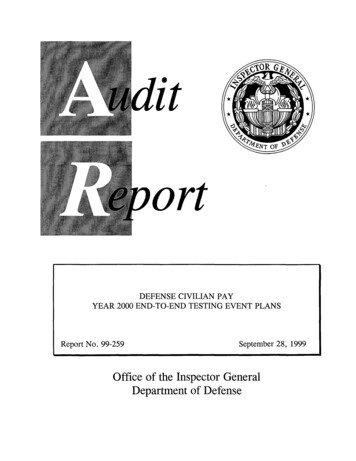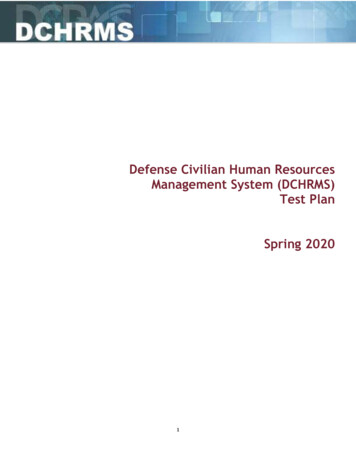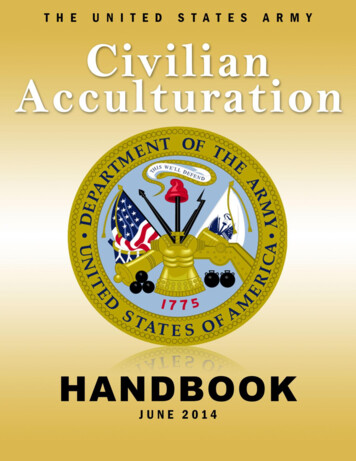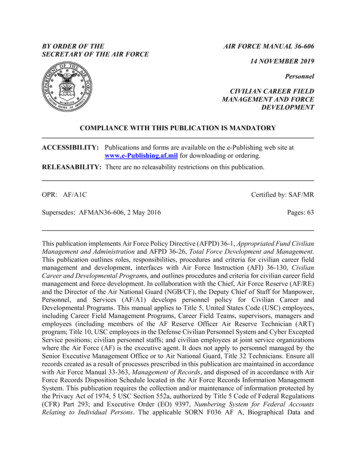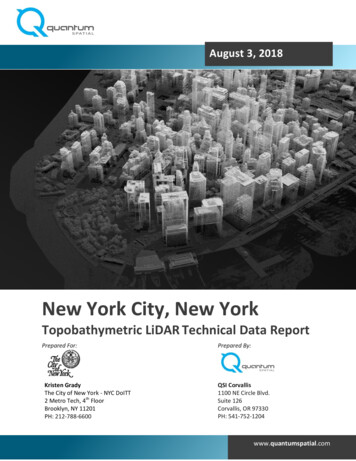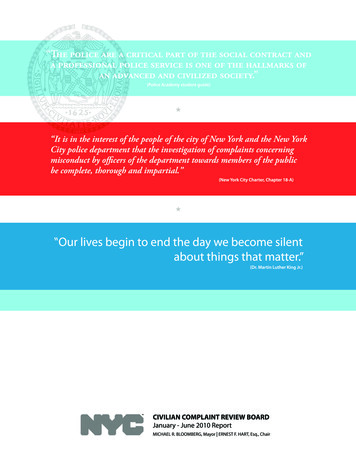
Transcription
CCRB Mission and ValuesThe New York City Civilian Complaint Review Board (CCRB) is an independent agency.It is empowered to receive, investigate, hear, make findings and recommend actionon complaints against New York City police officers alleging the use of excessive orunnecessary force, abuse of authority, discourtesy, or the use of offensive language.The Board’s investigative staff, which is composed entirely of civilians, conductsinvestigations in an impartial fashion. The Board forwards its findings to the PoliceCommissioner.In fulfillment of its mission, the Board has pledged: To encourage members of the community to file complaints when they feel theyhave been victims of police misconduct. To encourage all parties involved in a complaint to come forward and present evidence. To investigate each allegation thoroughly and impartially. To make objective determinations on the merits of each case. To recommend disciplinary actions that are fair and appropriate, if the investigationdetermines that misconduct occurred. To respect the rights of civilians and officers. To engage in community outreach to educate the public about the agency and torespond to concerns relevant to the agency’s mandate. To report relevant issues and policy matters to the Police Commissioner. To offer civilians and officers the opportunity to mediate complaints in order to resolveallegations and promote understanding between officers and the communitiesthey serve.This report covers the period of January 2010 through June 2010Volume XVIII, no.1New York City Civilian Complaint Review Board – www.nyc.gov/ccrb
1Table of ContentsTable of Contents . . . . . . . . . . . . . . . . . . . . . . . . . . . . . . . . . . . . . . . . . .1Letter from the Chair . . . . . . . . . . . . . . . . . . . . . . . . . . . . . . . . . . . . . . .2Who We Are . . . . . . . . . . . . . . . . . . . . . . . . . . . . . . . . . . . . . . . . . . . . . .3What We Do . . . . . . . . . . . . . . . . . . . . . . . . . . . . . . . . . . . . . . . . . . . . .5Complaints Received . . . . . . . . . . . . . . . . . . . . . . . . . . . . . . . . . . . . . . .6Location of Stop & Frisk Incidents Resulting in Complaints . . . . . . . . .7Complainant Demographics . . . . . . . . . . . . . . . . . . . . . . . . . . . . . . . . .8CCRB Dispositions . . . . . . . . . . . . . . . . . . . . . . . . . . . . . . . . . . . . . . . .9Agency Productivity . . . . . . . . . . . . . . . . . . . . . . . . . . . . . . . . . . . . . . .10Mediation . . . . . . . . . . . . . . . . . . . . . . . . . . . . . . . . . . . . . . . . . . . . . . .11Police Department Dispositions . . . . . . . . . . . . . . . . . . . . . . . . . . . . . .12
2Letter from the ChairCIVILIAN COMPLAINT REVIEW BOARD40 RECTOR STREET, 2 FLOORNEW YORK, N EW YORK 10006 TELEPHONE (212) 442-8833www.nyc.gov/ccrbNDMICHAEL R. BLOOMBERGMAYORERNEST F. HARTCHAIRJOAN M. THOMPSONEXECUTIVE DIRECTORDecember 2010Dear Members of the Public:I am pleased to present the Board’s Status Report for January – June 2010. In the past sixmonths the Board has continued to advance its mandate and mission. Our staff is successfullyimplementing the three priorities which the Board set forth at the beginning of my tenure inApril of 2009: improving the quality of investigations; increasing the number of mediations;and enhancing our outreach efforts.Improvement in the quality of CCRB investigations has not only led to greater public confidence,it has also resulted in stronger cases of substantiated misconduct being forwarded to thePolice Department, which has the sole authority to discipline officers. The strength of thesecases is evidenced in the numbers. Comparing January to June data of 2009 to this year, thediscipline rate for substantiated cases increased from 59% to 87% and the percentage of casesin which the Department declined to prosecute a CCRB case has decreased from 37% to 7%.We have expanded our highly successful mediation program. As a result, in the first half of2010, the CCRB mediated 91 cases – the most ever for any half-year period and a 40% increaseover the period January – June 2009, in which 65 cases were mediated.We have also increased public awareness of the CCRB and of the mediation and investigativeservices we offer by extending our outreach program. We began targeted outreach to residentsliving in public housing and gave 26 presentations at NYCHA locations and at schools, churches,and community groups serving NYCHA residents in the period January – June 2010. TheBoard also began to hold its monthly public meetings in the other boroughs, rather than onlyat its Manhattan office.Lastly, I am very pleased that we reached an agreement with the Police Department to launcha pilot program for our attorneys to be the lead prosecutors in CCRB cases that are broughtto administrative trial at the Police Department. This pilot program is made possible by thestrong support of Police Commissioner Raymond W. Kelly, the Mayor’s Office, the CityCouncil and numerous public interest organizations. I thank them all for helping us achievesuch an important milestone in the City’s history of civilian review.Sincerely,Ernest F. Hart, Esq.New York City Civilian Complaint Review Board – www.nyc.gov/ccrb
3Who We AreCCRB Board Members January–June 2010Mayoral DesigneesCity Council DesigneesPolice Commissioner DesigneesChair Ernest F. Hart, Esq.Daniel D. Chu, Esq.Dr. Mohammad KhalidDavid G. Liston, Esq.Mary E. Mulligan, Esq.James F. Donlon, Esq. (Staten Island)William F. Kuntz II, Esq. (Brooklyn)Bishop Mitchell G. Taylor (Queens)Youngik Yoon, Esq. (Bronx)Vacant (Manhattan)Jules A. Martin, Esq.Michael McCann, Esq.Tosano SimonettiCCRB Organizational ChartMembers of the BoardExecutive DirectorFirst Deputy Executive DirectorDeputy ExecutiveDirectorAdministrationTwo Assistant DeputyExecutive Directors forInvestigationsDirector ofPayroll andPersonnelDirectorof CaseManagementDirector ofManagementInformationSystemsDirector ofOperationsDirector ofMediationDirector ofCommunityRelationsand TrainingFive Investigative rmationSystems UnitOperationsUnitMediationUnitOutreachUnitEach team is supervised bya manager, a supervisor, andan assistant supervisorDirector ofResearch andStrategicInitiativesPressSecretaryDirectorof InterGovernmentaland LegalAffairs
4Agency Operations and ResourcesThe Civilian Complaint Review Board (CCRB)is an independent City agency that investigates andmediates complaints of misconduct that members ofthe public file against New York City Police Department(NYPD) officers. The CCRB was established in itsall-civilian form in 1993.The current Board is comprised of thirteen memberswho reflect the diversity of the City’s population. TheCity Council designates five Board members (one fromeach borough); the Police Commissioner designatesthree; and the Mayor designates five, including theChair. Board members review and make findings onall misconduct complaints once they have been fullyinvestigated by its staff. If the Board finds that an officercommitted misconduct, it then makes disciplinaryrecommendations to the Police Commissioner.The Board hires the Executive Director who isresponsible for the agency’s daily operations, includingthe hiring and supervision of the agency’s staff. TheInvestigations Division is currently comprised of fiveteams, down from eight, each led by a highly experiencedmanager. In addition to investigating complaints theNew York City Civilian Complaint Review Board – www.nyc.gov/ccrbagency has a Mediation Unit which, in eligible cases,gives people the opportunity to mediate their complaints.The Mediation Unit also coordinates educational andtraining programs on mediation for police officers,civilians, and CCRB staff.The Administrative Division manages the agency’slarge-scale computerized Complaint Tracking System(CTS), produces statistical analyses of complaintactivity, processes cases for Board review, managesoffice operations and vehicle fleet, and performsbudgeting, purchasing, personnel, and clerical services.The Administrative Division includes an OutreachUnit which makes presentations at community groupsthroughout the City to increase public awareness ofthe services the CCRB provides.Budgetary reductions taken in FY 2010 reducedthe CCRB’s budget. As of June 30, 2010, the agency lost35 positions, the vast majority from the InvestigationsDivision. This lowered the CCRB’s authorized headcount from 180 to 145 for FY 2010. For FY 2011,which starts July 1, 2010, the adopted budget willsupport 153 positions.
5What We DoJurisdiction and Case ProcessingThe CCRB investigates and mediates complaintsagainst NYPD officers involving four types of allegations:Force, Abuse of Authority, Discourtesy, and OffensiveLanguage (FADO). Members of the public can filecomplaints directly with the CCRB through the City’s311 system, the CCRB’s Web site, by fax, by mail,and in person at the CCRB’s office or at any policestationhouse.Once a complaint is received, an investigator takesover and conducts an in-depth investigation.Investigations typically include interviewing thecomplainant and the subject police officers, obtainingall relevant documentary evidence, including medicalrecords and Police Department documents such as rollcalls, officer memo books, radio dispatch reports, arrestreports, precinct command logs, and “stop, questionand frisk” reports. The investigator then writes a reportsummarizing the results for review by the Board. If theBoard substantiates an allegation of misconduct, thecase is forwarded to the Police Commissioner, who hasthe final authority to impose discipline.Types of CCRB Allegations Force refers to the use of unnecessary or excessiveforce up to and including deadly force. Abuse of Authority refers to improper streetstops, frisks, searches, the issuance of retaliatorysummonses, unwarranted threats of arrest, andother similar actions. Discourtesy refers to inappropriate behavioror language, including rude or obscene gestures,vulgar words, and curses. Offensive Language refers to slurs, derogatoryremarks, and/or gestures that are made in referenceto a person’s sexual orientation, race, ethnicity,religion, gender, or disability.CCRB Investigation Outcomes Substantiated: The Board found sufficientcredible evidence to believe that the subjectofficer committed the act charged in theallegation and committed misconduct. Exonerated: The Board determined that althoughthe act at issue occurred, the subject officer’sactions were lawful and proper and within thescope of the subject officer’s authority underNYPD guidelines. Unfounded: The Board determined that the actthat is the basis of the allegation did not occur. Unsubstantiated: The Board determined thatthere is insufficient evidence to establish whetheran act of misconduct occurred. Officer(s) Unidentified: The Board was unable toidentify the subject(s) of the alleged misconduct. Miscellaneous: Generally used by the Board whenthe subject officer is no longer employed by theNYPD and therefore the Board has no jurisdiction.
6Complaints ReceivedCCRB Complaints ReceivedJanuary 2006–June 21,0605000Jan-June July-Dec Jan-June July-Dec Jan-June July-Dec Jan-June July-Dec20062006200720072008200820092009Complaint activity in the first half of 2010 wasat its lowest level for any six-month period sinceJanuary 2005. During this period, the CCRB received3,314 misconduct complaints. In comparison, 4,017misconduct complaints were filed during January –June 2009. This difference of 703 complaints is adecrease of 18%.While the precise reasons for the decrease arenot known, there are two influencing factors. First,the number of callers referred to CCRB by the City’s“311” hotline declined 12% from January – June 2009to January – June 2010.Second, the number of “stop, question and frisk”complaints also decreased by 12%, from 1,222 in thefirst half of 2009, to 1,076 in the first half of 2010.In the first half of 2009, there were 311,646 “stop,question and frisks” (stops) conducted by the NYPDand CCRB received complaints at the rate of onecomplaint per 255 stops. In thefirst half of 2010, there were318,702 stops and CCRB receivedone complaint per 296 stops.However, the proportion100.0%of stop, question, and friskTotal CCRBcomplaints as a percentage of90.0% complaintsall other complaints has remainedrelatively steady. In the first half80.0%Number3,314of 2009, 30% of all complaintsof CCRBfiled were stop, question andcomplaints70.0%involvingfrisk complaints. In the sameat least one60.0% allegationperiod of 2010, 32% of allof question,complaints filed were stop,50.0% stop, friskquestion and frisk complaints.and/or searchWhile the quantity of40.0%complaintsreceived has32.5%Percentagedecreasedfrom2009 to 2010,30.0% of CCRBcomplaintsthe characteristics of thoseinvolving atcomplaints have largely remained1,076 20.0% least oneallegationthe same. In both years, 65% of allof question,complaints involved an allegation10.0% stop, friskof abuse of authority, 41%and/or search0.0%involved an allegation ofJan-Junediscourtesy and 7% involved2010offensive language. The onedifference was in the proportionof complaints that contained at least one allegation offorce. During January – June 2009 it was 53%, whichdeclined to 51% during January – June 2010.In addition to FADO complaints – use of force,abuse of authority, discourtesy, or use of offensivelanguage – the agency also takes in many morecomplaints that fall outside its statutory mission andare therefore referred to the appropriate jurisdiction.During the first half of 2010, the CCRB referred5,311 cases to other agencies, the vast majorityto the NYPD’s Internal Affairs Bureau (IAB) andthe Office of the Chief of Department (OCD).In comparison, in the first half of 2009, the CCRBreferred 5,790 cases. The total intake for January –June 2010 was 8,625 filings. Total intake for January –June 2009 was 9,807. This is a 12% decrease intotal intake from January – June 2009 comparedto January – June 2010.New York City Civilian Complaint Review Board – www.nyc.gov/ccrb
Location of Stop, Question and FriskIncidents Resulting in ComplaintsThe map illustratesDensity of Stop, Question, and Frisk Complaint Filingsthe distribution of stop,January 2009–June 2010question and frisk complaintsthroughout New York Cityfrom January 2009 throughJune 2010, based upon thelocation of the incident that50led to the complaint. As470-25 Complaints45discussed in previous reports,5226-50 Complaintsthe relative distribution ofcomplaints throughout the3451-89 Complaints4946City has generally remained4890 or More Complaintssteady in the past five years.33424445This map does not reflect3043population density, crime322641statistics, precinct size, or28 2540the number of uniformed2423personnel assigned to aCPP20precinct.19MTNDuring this period,MTSthere were nine precincts1091141710115111with incidents that resulted136110in ninety or more stop,108910794question and frisk complaints.1125 71104Four of these precincts105901038310284 88were in Brooklyn – the79 8112011367th, 73rd, 75th and the761067773787579th; four were in the7172122Bronx – the 40th, 44th,676946th, and the 47th; and one66 7068was in Staten Island – the6362101123120th. The 75th Precinct,61located in the East New60100York section of Brooklyn,had 201 stop, questionand frisk complaints – thehighest in the City.100th, 102nd, 104th, 106th, 107th, 108th, 109th,Other precincts with high stop, question and frisk110th, 111th and the 112th. Eleven precincts were incomplaint activity include: Manhattan North – theManhattan – the 1st, 5th, 6th, 10th, 13th, 17th, 19th,32nd Precinct had 89; the 23rd had 83; the 28th had20th, 24th, 26th, and Central Park. And two precincts80; and the 25th had 77. In the Bronx – the 42ndwere in Staten Island – the 122nd and the 123rd. ThePrecinct had 76 and the 43rd had 75. In Brooklyn –111th Precinct in Queens and the Central Parkthe 77th Precinct had 81.Precinct had three stop, question and frisk complaintsThere were 31 precincts that had incidents resultingeach – the lowest number in the City. The 111thin 25 or fewer stop, question and frisk complaints inPrecinct serves six neighborhoods: Bayside, Douglaston,this 18-month period. Eight of these precincts wereLittle Neck, Auburndale, Hollis Hills, and Fresh Meadows.in Brooklyn – the 61st, 62nd, 63rd, 66th, 68th, 76th,78th, and the 94th. Ten precincts were in Queens – the7
8Complainant Demographicscomplainants, 59%, and thispercentage is much greater thanBlack representation in the City’spopulation as a whole, which is23%. Another constant was thatWhites and Asians continued torepresent a disproportionatelylow percentage of complainants.Whites represented 10% ofcomplainants while making upBronx35% of the City’s population.BrooklynAsians filed only 2% of complaints,yetrepresent 12% of theManhattanpopulation. Hispanics makeQueensup the second highest group ofStaten Islandcomplainants at a rate of 25%,and this number was similar toNon-CityResidentstheir representation within theCity population, which is 28%.It is important to note that inapproximately one out of threecomplaints the CCRB was notable to capture the race of theperson making the complaint.The CCRB has also compileddata on the distribution ofcomplainants throughout the City by borough ofresidence from January – June 2010. Brooklyn residentsmake up the largest percentage of CCRB complainants– approximately 34%; followed by the Bronx – 26%;Manhattan – 16%; Queens – 14%; and Staten Island –5%. Additionally, non-City residents filed approximately6% of complaints during this period.CCRB Complainants by Location of Residence Comparedto New York City 14%10%5%5%6%6%0%CCRB Complainants by Borough(Jan - June 2010)New York City Demographics(American Community Survey 2008)Historically, the breakdown by race of CCRBcomplainants has differed greatly from the breakdownby race of the City’s population as reported by theUnited States Census Bureau.The current racial makeup of CCRB complainantsremains consistent with that of prior years. One ofthese constants is that Blacks represent the majority ofNew York City Civilian Complaint Review Board – www.nyc.gov/ccrb
CCRB DispositionsBoard DispositionsDisposition of Investigated Cases,Each CCRB case isJanuary 2006–June 2010comprised of one or moreFADO allegations. Somecases are fully investigatedwhile others are truncated3,00068%67%because a full investigation2,778cannot proceed.2,55766%2,49866%With full investigations,2,5002,4292,3572,3192,310the Board reviews a case and2,23263%determines whether or not64%63%the majority of the evidence1,96063%2,000indicates that the officer(s)Fullinvestigationscommitted the alleged act of62%61%1,5091,488misconduct. This standard isTruncated1,4481,5001,409investigations60% 60%known as “preponderance of1,3861,202Truncation1,18559% 60%the evidence.” If the Board1,172rate1,022finds misconduct, it closes1,000the case as Substantiated.58%The Board closes a case as:Unsubstantiated if it finds that500the evidence is insufficient56%to make a determination;Unfounded if it finds that54%0the officer did not commitJan-Jun July-Dec Jan-Jun July-Dec Jan-Jun July-Dec Jan-Jun July-Dec Jan-Junthe alleged act of misconduct;200620062007200720082008200920092010and Exonerated if the officer’salleged actions were determinedto be lawful and proper. CasesOf the 1,448 cases that were closed as fullare also closed as Officer Unidentified if identificationinvestigations, 146 (10%) were closed as Substantiated.cannot be made and as Miscellaneous generally if theThis is an increase over the first half of 2009 both inofficer is no longer employed by the NYPD.the number of substantiated cases (85) and in theCases are Truncated when the complainantsubstantiation rate (7%).and/or alleged victim(s) withdraw the complaint,Given that each case consists of one or morerefuse to provide a formal statement, or cannot beallegations, the CCRB also analyzes Board dispositionslocated. The Board then closes the case as: Complaintby allegations. The percentage of allegations substantiatedWithdrawn; Complainant/Victim Uncooperative;in fully investigated cases increased from 4% (212 outComplainant/Victim Unavailable; or Victim Unidentified,of 4,770) in the first half of 2009 to 5% (290 out ofdepending on the underlying circumstances. At the5,297) in the first half of 2010. The percentage ofBoard’s discretion, a truncated case may be re-openedallegations that were unsubstantiated during thisupon request.period decreased from 39% of all fully investigatedThe CCRB closed 3,894 cases during the period ofallegations in the first half of 2009 to 34% in the firstJanuary – June 2010. In comparison, the agency closedhalf of 2010. The percentage of allegations that were3,704 cases during the same period of 2009. This is aexonerated and those determined to be unfounded5% increase in the number of closures. Of these closedincreased slightly. In the first half of 2009, 32% ofcases, 1,448 (37%) were full investigations and 2,310allegations were exonerated and 13% were unfounded.(59%) were truncated. The remaining 136 (4%) wereSimilarly, in the first half of 2010, 34% of allegationsclosed through the Mediation Unit. In the same periodwere exonerated and 15% were unfounded. Allegationsof 2009, the board closed 1,185 (32%) full investigations,where the officer was unidentified increased from 9%2,429 (66%) truncations, and 90 cases (2%) throughfor the first half of 2009 to 10% for the first half of 2010.the Mediation Unit.9
10Agency Productivity350On June 30, 2010, tencases were 18 months orolder, 0.3% of the opendocket. In comparison, onJune 30, 2009, forty-sevencases were 18 month orolder – or 1.1% of the opendocket.300Completion TimeAverage Number of Days to Complete a Full InvestigationJanuary 2006–June 2010400Days250200150100500During the first half of2010, the average numberof days it took the agencyAveragetoclose a full investigationnumber ofdaystodecreasedby 45 days, or359340complete32513%.Duringthe first half of314308305303a full2822802010,ittookan average ofinvestigation314 days to complete a fullinvestigation and duringthe first half of 2009 ittook an average of 359 days.Similarly, the average numberof days it took to close aJan-Jun July-Dec Jan-Jun July-Dec Jan-Jun July-Dec Jan-Jun July-Dec tiated investigationdecreased by 48 days, or11%. During the first halfof 2010, it took an averageThe CCRB uses three key indicators to measureof 374 days to complete a substantiated investigationits productivity: the size and the age distribution ofand during the first half of 2009, it took an average ofthe open docket; the time it takes to complete an422 days.investigation; and the average number of closures perinvestigator. The CCRB uses the term open docket toInvestigators’ Case Closuresrefer to the number of open cases being processed byThe agency also saw an improvement in thethe agency at a given time. By all three measures theaverage number of case closures per investigator,agency’s productivity improved.which was higher than the average number of casesclosed in any prior period. From January – June 2010Docket Size and Ageeach investigator closed an average of 39 cases, anThere were 2,852 cases that remained open as ofincrease from the average of 33 cases during January –June 30, 2010, compared to 4,120 cases that remainedJune 2009. This figure represents a 17% increase inopen as of June 30, 2009. The difference of 1,268 casesinvestigator productivity.represents a 31% reduction.New York City Civilian Complaint Review Board – www.nyc.gov/ccrb
MediationThis is a process whereTotal Number of Mediation Unit Closurescivilians and police officers meetJanuary 2006–June 2010with a trained, neutral mediatorto address the issues raised bythe complaint. Participation160in mediation is voluntary forboth officers and civilians. The140mediator guides discussionbetween the parties to helpthem resolve the complaint.12045Cases are closed as “Mediated”when both parties agree that1007359the issues have been resolved.Mediation65The agency closes cases as3961attempted80“Mediation Attempted” when25the civilian and officer haveMediated4641agreed to mediate but the60civilian twice fails to appear91for the mediation without40good cause, or fails to respond6865646256to phone calls, e-mails, or letters53484620to set up the mediation session.The CCRB has the largestvoluntary mediation program in0Jan-Jun July-Dec Jan-Jun July-Dec Jan-Jun July-Dec Jan-Jun July-Dec Jan-Junthe United States for nst the police and hasconsistently improved theprogram. In the first half of2010, the CCRB mediated 91 cases – the most everincreased. In the first half of 2010, 320 out of 383 orfor any half-year period. This was an increase of 40%84% of officers agreed to mediate their complaints.compared to the 65 mediations during the first halfIn the first half of 2009, 132 out of 179 officers agreedof 2009. The CCRB also closed 45 cases during thisto mediation, or 74%.period as “Mediation Attempted.” In the same periodIn keeping with emerging national standards inof 2009 year, the agency closed 25 cases as “Mediationcivilian oversight, the Mediation Unit began distributingAttempted.”a Civilian-Officer Satisfaction Survey in June of 2009Last year the NYPD and the Patrolmen’s Benevolentin order to monitor how satisfied participants are withAssociation (PBA) began meeting with the CCRB tothe mediation process and outcome. Results show thatdiscuss ways to educate police officers about complaintover ninety percent of officers and civilians are satisfiedmediation. Subsequently, both the NYPD and the PBAwith the CCRB’s mediation program in two key areas:issued public statements supporting mediation andrespect for the process and satisfaction with the outcome.Nearly ninety percent said they would recommendencouraging officers to participate. As a result, the ratemediation to others.at which officers agree to participate in mediation has11
12 9Police Department DispositionsPolice Department Pursued Discipline in SubstantiatedCCRB Cases January 2006–June 201020018016036140Officerfound notguilty aftertrial structionsOfficerfound guiltyafter trialor pleadguilty151596255Jan-June July-Dec Jan-June July-Dec Jan-June July-Dec Jan-June July-Dec lice Department Action in SubstantiatedCCRB Cases January 2006–June 2010250Status oflimitationsexpired200566112615060737100Filed (Officerresignedbefore PDaction)1136101211674048494221871 171495010295989010785970Jan-June July-Dec Jan-June July-Dec Jan-June July-Dec Jan-June July-Dec Jan-June200620062007200720082008200920092010New York City Civilian Complaint Review Board – www.nyc.gov/ccrbNYPD PursuedNo Discipline(Departmentdeclined toprosecute)NYPD ipline, ordepartmentalcharges)ComWhen the Board determinesthat an officer committedmisconduct, it forwards the caseto the Police Commissioner witha disciplinary recommendation.Pursuant to the New York CityCharter, the Police Commissionerhas sole discretion over whetherto issue discipline and the levelof punishment if discipline isimposed.In the first half of 2010, thePolice Department closed 105cases that had previously beensubstantiated by the CCRB. TheDepartment pursued disciplinein 96 cases and did not pursuediscipline in 9 cases. This is adiscipline rate of 87%.Of the cases in which theDepartment pursued discipline,4 officers pled guilty and 7 officerswent to trial. Of the 7 cases thatwent to trial, 6 officers werefound not guilty and 1 officerwas found guilty. In addition,33 officers received CommandDiscipline and 52 officers receivedInstructions or re-training.Of the 9 cases in whichthe Department did not pursuediscipline, one case was “filed,”meaning the officer had left theDepartment but would facediscipline if he or she returned,one case was closed as “statuteof limitations expired,” and theDepartment declined to pursuediscipline in 7 cases (7%). Thenumber of declinations for thefirst half of 2010 decreasedsignificantly from the three priorhalf-year periods, during whichthe Department declined topursue discipline in 30% of cases.
13CCRB DispositionsOn February 18, 2010, Board Chair Ernest F. Hartand Police Commissioner Raymond W. Kelly announcedan agreement to launch a pilot program in which CCRBattorneys will prosecute, in the Police Department'strial room, a portion of the cases substantiated by theBoard. Since then, the CCRB has secured funding forthe program and working with the NYPD, set thefoundations for its launch in the fall of 2010. This pilotprogram builds upon the success of the second-seatingprogram launched in September of 2008. Under thesecond-seating agreement, a CCRB attorney acts assupporting counsel to the assigned Departmentprosecutor. This joint venture was undertaken toensure that both agencies work cooperatively towardsthe successful adjudication of cases referred from theCCRB. Previously, only civilian lawyers employed bythe NYPD’s Department Advocate’s Office prosecuteddepartment disciplinary cases.
"311" hotline declined 12% from January - June 2009 to January - June 2010. Second, the number of "stop, question and frisk" complaints also decreased by 12%, from 1,222 in the first half of 2009, to 1,076 in the first half of 2010. In the first half of 2009, there were 311,646 "stop, question and frisks" (stops) conducted by .





